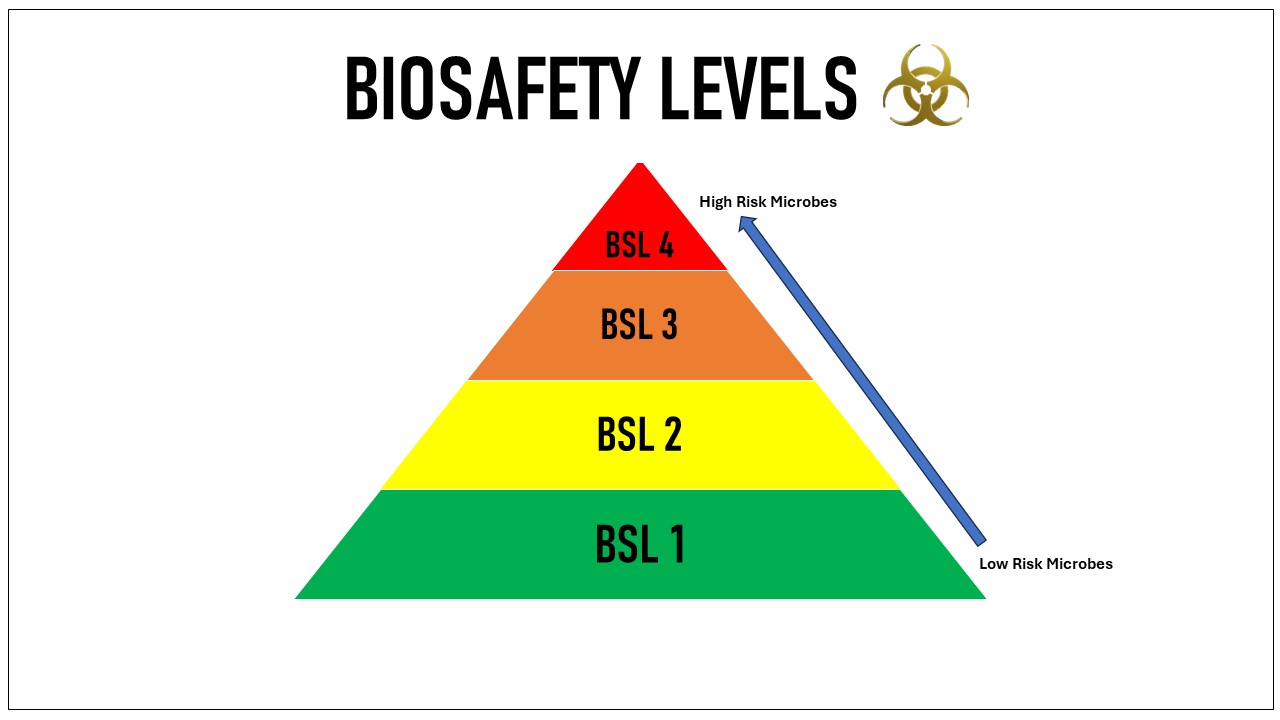The biosafety levels determine the measures used to protect the workers, a necessary laboratory requirement. To achieve suitable biosafety and biocontainment, a variety of tools, procedures, and laboratory design elements can be combined. These are established by biological risk analyses that are carried out, especially for each experimental technique.
By biosafety level, activities and projects carried out in biological laboratories are divided. The utmost (highest) level of containment is BSL-4, while the other three levels are BSL-1, BSL-2, and BSL-3. Agricultural research (BSL-Ag), animal research (ABSL), and other sorts of research all have their unique regulations and designations. Because they work with bigger species like plants, animals, and insects, these other types of labs need their own unique set of rules and regulations.
The CDC establishes biosafety standards to specify the particular safeguards that a laboratory must have in place to keep bacteria and biological agents contained. Each level of biosafety builds on the one before it, imposing successive layers of restrictions and obstacles.
Each biosafety level, from BSL-1 to BSL-4, is determined using the following guidelines:
1. The dangers of the enclosure
2. Infection severity
3. The type of work done in the laboratory
4. Agent in question Origin of the microorganism Route of exposure
5. Transmissibility
Biosafety Levels
Biosafety Level 1 (BSL1)
BSL-1 laboratories are employed for the research of infectious agents or toxins that are not known to reliably cause disease in healthy individuals. They don’t need any specialised tools or architectural elements and adhere to fundamental safety practices known as Standard Microbiological practices. Surfaces that are simple to clean and resistant to the common chemicals used in laboratories with a BSL-1 rating are examples of standard engineering controls.
If you operate in a lab that has been given the BSL-1 designation, the bacteria inside are not known to regularly cause illness in healthy humans and pose a low risk to lab workers and the environment. A nonpathogenic strain of E. coli is an illustration of a bacterium that is generally handled at a BSL-1.
The following are some particular factors to take into account for a BSL-1 laboratory:
Procedures for testing
- There is adherence to accepted microbiological procedures.
- Work can be done on a table or open lab bench.
Safety gears
When necessary, personal protective equipment (lab coats, gloves, and eye protection) is worn.
Facility construction
- There needs to be a washbasin nearby for hand washing.
- Doors should be installed in the lab to divide the working area from the rest of the building.
Biosafety Level 2 (BSL 2)
Infectious agents or toxins with a moderate level of risk that might be dangerous if unintentionally breathed, eaten, or exposed to the skin are studied in BSL-2 facilities. Design specifications for BSL-2 laboratories must have automated closing and locked doors, eye cleaning stations in case of mishaps, and hand washing sinks. BSL-2 laboratories must also have access to decontamination tools, such as an autoclave, an incinerator, or another technique, depending on the results of the biological risk assessment.
BSL-2 advances BSL-1. The bacteria present in a facility with a BSL-2 designation represent a moderate risk to workers and the environment. In most cases, the microorganisms are local and linked to illnesses of various severity. Staphylococcus aureus is an illustration of a microorganism that is frequently handled in a BSL-2 laboratory.
The following safety measures must be established in BSL-2 laboratories:
- PPE, such as lab coats, gloves, eye protection, and – in some circumstances — face shields, must be worn.
- A biological safety cabinet must be used for any procedures that can spread disease by aerosols or splashes.
- Before disposal, infected items are usually decontaminated using an autoclave.
- Lockable, self-closing doors
- A washbasin and eyewash station are available.
- Warning signals for biohazards
Read more: GelDoc: A Revolutionary Tool for DNA and Protein Analysis
Biosafety Level 3 (BSL 3)
Infectious substances or poisons that might spread through the air and cause potentially fatal infections are studied in BSL-3 facilities. All studies are carried out in biosafety cabinets, which employ tightly regulated airflow or enclosed enclosures to avoid infection. BSL-3 laboratories are built with simple decontamination in mind. As an added safety precaution, these laboratories must utilise regulated, or “directional,” airflow to make sure that air flows from non-laboratory regions (such the corridor) into laboratory spaces.
The containment standards of BSL-2 are expanded upon by BSL-3. If you operate in a lab with a BSL-3 designation, the bacteria inside may be domestic or foreign and they may transmit sickness through the respiratory system that is serious or potentially fatal. The exposure pathway through inhaling is respiratory transmission. Mycobacterium tuberculosis, the organism that causes TB, is an illustration of a microbe that is normally handled in a BSL-3 laboratory.
The following containment criteria apply to BSL-3 laboratories in addition to BSL-2 considerations:
Testing procedures
- Laboratories are monitored by medical personnel, and workers with microorganisms may be immunised.
- The lab is always secured and under stringent monitoring of access.
Safety apparatus
All work with microorganisms must be done in a suitable BSC, and proper PPE must be used, including respirators if necessary.
Facility construction
- Near the exit, there is a hands-free washbasin as well as an eyewash station.
- Exhaust air cannot be cycled, and the laboratory has to maintain a directed airflow by pulling air in from possibly polluted sections and out of clean areas.
- There are two sets of self-closing and locking doors that lead inside the lab.
Biosafety Level 4 (BSL 4)
BSL-4 facilities are used to investigate pathogens or toxins that have a high risk of spreading by aerosols and causing serious illnesses for which there is no cure or vaccination. The labs are equipped with all BSL 3 characteristics and are located in safe, secure areas of bigger buildings or they might be placed in a separate, special structure. Access to BSL-4 laboratories is strictly regulated and necessitates extensive training.
The most stringent level of biological safety is BSL-4, which expands on the containment standards of BSL-3. BSL-4 laboratories are scarce both in the United States and abroad. A BSL-4 lab contains hazardous and unusual microorganisms that increase the risk of illnesses spread by aerosols. These microorganisms can cause infections that are usually deadly and for which there is no cure or vaccination. Ebola and Marburg viruses are two examples of microorganisms used in BSL-4 laboratories.
The following containment criteria apply to BSL-4 laboratories in addition to BSL-3 considerations:
Testing procedures
- Before entering, change your attire.
- shower after leaving.
- Clean up everything before you go.
Safety apparatus
A full body, air-supplied, positive pressure A suit or a suitable Class III BSC must be used for any job involving the microorganism.
Structural construction
- The laboratory is located in a separate structure or a confined area within a building.
- Vacuum lines, disinfection systems, and dedicated supply and exhaust air are all present in the laboratory.
References: www.phe.gov, www.cdc.gov, consteril.com
Graduated from the University of Kerala with B.Sc. Botany and Biotechnology. M.Sc. Biotechnology from the University of Kerala. Attended certificate course in Artificial Intelligence for Everyone from Deeplearning.AI, Influenza Prevention and Control from World Health Organization. Attended workshops related to Bioinformatics at the University of Kerala. 3 years of experience in website management. Experience in WordPress, Blogger, Google Analytics, and Google Search Console.








One thought on “Biosafety Levels: BSL-1, BSL-2, BSL-3, BSL-4 Laboratories”
Comments are closed.